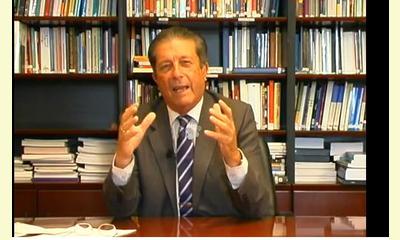|
|
Federico Mayor: Introduction to the Culture of Peace
un article par Fundacion Cultura de Paz
Video: Federico Mayor: Culture of Peace
During the twelve years he spent as head of UNESCO (1987-1999), Professor Mayor Zaragoza gave new momentum to the Organization's mission, "to build the bastions of peace in the minds of men". It became an institution at the service of peace, tolerance, human rights and peaceful coexistence, by working within its areas of authority and remaining faithful to its original mission. Following Professor Mayor's guidelines, UNESCO created the Culture of Peace Program, whose work falls into four main categories: education for peace, human rights and democracy, the fight against exclusion and poverty, the defense of cultural pluralism and cross-cultural dialogue, and conflict prevention and the consolidation of peace.

click on photo to enlarge
Within the framework of this strategy, many international meetings and conferences were held on education for non-violence, eradicating discrimination and promoting pluralism and international cooperation. These meetings resulted in a considerable number of Declarations (thirty), expressing a will to promote education, science, culture, research and teaching, as well as justice and "intellectual and moral solidarity", referred to the Constitution of the UNESCO. On September 13, 1999, the United Nations General Assembly approved the Declaration and Programme of Action on a Culture of Peace, which constitutes, from a conceptual and practical standpoint, the greatest aspirations of Professor Mayor Zaragoza.
With the Fundación para una Cultura de Paz, founded in Madrid in March, 2000, Professor Mayor continues with the work he started as Director-General of UNESCO: to promote, in every area of human life, the transition from a culture of violence and imposition to one of peace and tolerance. In December, 2000, he organized an International Meeting, which was attended by well-known personalities who have fought for justice, freedom and peace. At the end of that meeting, the Madrid Declaration was unanimously approved and it was published, with the interventions, in the book "El Contrato Global". . .
In October 2005 be was appointed by the UN Secretary General Kofi Annan co-chair of the High-Level Group for the "Alliance of Civilizations". The Report of the HLG was presented in Istanbul in November 2006. . .
Among other activities of national and international cooperation, it emphasizes the creation, in the Univesidad Politécnica de Cataluña, of the World-wide Forum of the Civil Society, "UBUNTU", intended as a network of networks, an organisation of organisations to combine official notices, positions and proposals, since 2001 concentrates its dedication to the Reform of International Institutions.
(Click here for a Spanish version of this article)
|








|
DISCUSSION
Question(s) liée(s) à cet article:
Understanding the culture of peace , What are the key videos?
* * * * *
Commentaire le plus récent:
To begin this discussion, here are videos from three people who first developed the culture of peace concept at UNESCO and the United Nations:
Anwarul Chowdhury: Culture of Peace
David Adams: Culture of Peace
Federico Mayor: Culture of Peace
Federico Mayor: Cultura de Paz

|
|









